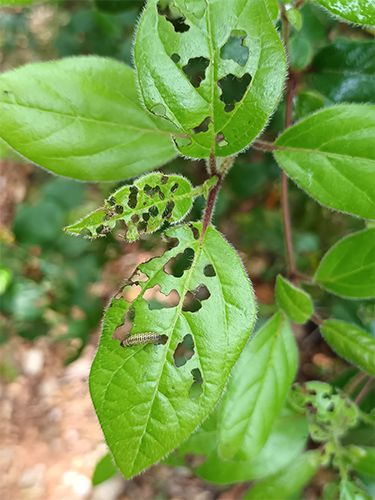Enjoying Some Flowers While Waiting for Food: Flower-eating Habits of the Viburnum Leaf Beetle

The viburnum leaf beetle Pyrrhalta viburni is an invasive pest in North America that defoliates plants belonging to the genus Viburnum (Figure 1). Viburnums are popular ornamental plants that are used in gardens and managed landscapes worldwide. In North America, native viburnums are an important component of forest understories, and their fruits provide food for overwintering birds.
Viburnum leaf beetle is native to Eurasia where it mainly occurs on three host plants: Viburnum opulus, V. lantana and V. tinus. The former two species are adapted to temperate and continental climates and lose their leaves during winter. The latter species is an evergreen shrub that is adapted to the Mediterranean climate.
Researchers at European Biological Control Laboratory (EBCL) are investigating factors that play a role in regulating populations of viburnum leaf beetle in its native range. First, surveys for natural enemies are conducted with hopes of identifying possible biological control candidates. Additionally, studies are performed to investigate the role of plant defenses and environmental conditions as regulating factors. These additional studies have revealed some interesting insect-plant interactions that only occur between viburnum leaf beetle and its Mediterranean host V. tinus.
Viburnum leaf beetle larvae emerge in the spring. Egg hatch is generally very well synchronized with the growth of new leaves of Viburnum shrubs. Young leaves, which are tender and nutritious, constitute the main food of larvae to complete their development. However, the growth of new leaves of V. tinus is unpredictable. Because V. tinus is an evergreen shrub, it does not need to produce young leaves in the spring. As a result, viburnum leaf beetle larvae may hatch on V. tinus in absence of young leaves. Because they are unable to feed extensively on older leaves, which are much tougher, larvae are doomed to die… Or are they?

Field observations and laboratory experiments have shown that young larvae are resourceful and can feed on the flowers of V. tinus (blooming period: late winter to early spring) when they are facing an absence of young leaves (Figure 2). In fact, they can complete their development feeding solely on flowers. However, flowers seem to be a suboptimal source of food, and larvae show decreased survival, decreased weight gain, and take longer to develop when feeding on flowers.
The flexibility of this beetle in its dietary preferences is an indicator of its toughness and resourcefulness. It is not surprising that it managed to adapt quickly to novel host plants (native North American viburnums) in its invasive range.
Author: Gaylord Desurmont
The European Biological Control Laboratory (EBCL) was established in 1991 near Montpellier, France. EBCL was created by the merger of the former European Parasite Laboratory, established in Paris in 1919, and the Biological Control of Weeds Laboratory in Rome. EBCL has a satellite laboratory in Thessaloniki, Greece. As the only USDA ARS-operated laboratory outside the United States, EBCL develops biological control technologies which can be used to suppress invading weeds and insect pests of Eurasian origin. EBCL researchers do this by searching for natural enemies (insects, mites, and pathogens) in their native habitat, determining their identity, testing their host specificity and potential impact in laboratory and field experiments, and shipping promising organisms to the U.S. for further testing as biological control agents. EBCL collaborates with scientists in many countries in Europe, Asia, and Africa to explore in regions of origin of the target weeds and insects.
